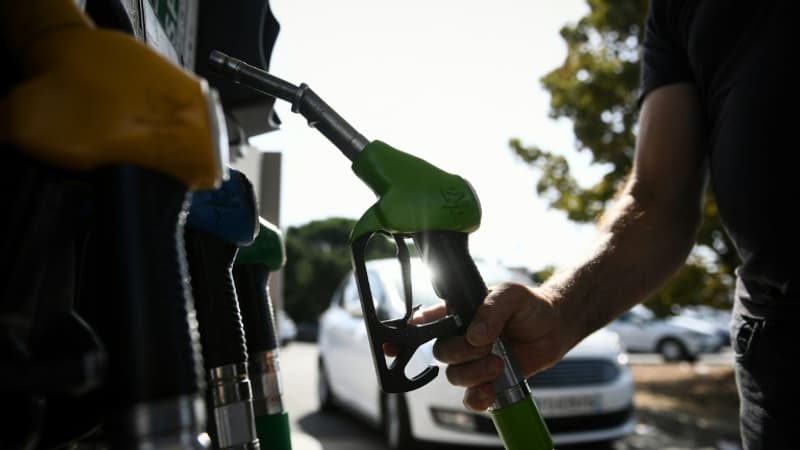Get out of the discount at the pump that benefits everyone, make way for a “specific” measure. Mentioned several times in the past, the idea of dedicated support for “big rollers” is far from being buried by the government. To the point that the Minister of Economy put it back on the table this Thursday.
guest on RTL, Bruno Le Maire announced that the discount at the pump will not extend into 2023. It rose to 30 cents in September and October, so it will drop to 10 cents on November 1, before disappearing on December 31, 2022. But the government no does not intend to leave motorists without a solution in the face of a possible continuation of the rise in fuel prices. To deal with it, he announced the establishment of another support system.
“If one day prices increase (…) I do not exclude support for motorists, for all those who have no choice but to take their car to go to work,” he said, before specifying: “it will be targeted support” .
“This emergency system exists and is funded. We have provided an envelope of 1.7 billion euros in the 2023 draft budget,” he said a little later in the day.
Who will play it?
Contacted by BFMTV, the Ministry of Economy gave some details about this new targeted aid. “It will be intended for employees, apprentices, public officials and the self-employed who are forced to take their vehicle to go to work,” Bercy informed us. The amount of the benefit will then be modulated according to the level of income and the composition of the household.
Finally, “it will include a ‘bonus’ for people who live more than 30 kilometers from their place of work or travel more than 12,000 kilometers a year in the professional context,” adds the ministry.
But this is not the first time the executive has considered such a device. And it was the Prime Minister herself who promised it a few months ago.
“For those who travel many kilometers a day, either to get to work, or as part of their work”, a device will be installed (…) at the beginning of the school year to accompany (them),” Elisabeth Borne assured on 7 of June.
A device that was already on the table in the past
At the beginning of July, the outlines of aid delivered on the basis of income criteria, easier to draw, were slowly taking shape. But it took more the form of a fuel control, on the model of the energy control, already planned in the fall of 2021.
At that time, the option of a device reserved for motorists who received between 1,500 and 1,800 euros net per month was on the table. In keeping with the spirit of the “big wheels” device, the government planned to target only the active, that is, working people, the unemployed, and workers who study and work. On the other hand, retirees and students were excluded from the project. In addition, an additional “big-wheeled vehicle” was envisioned for motorists who travel more than 12,000 kilometers per year.
Schemes that the government should finally resume, with some details. Like the one imagined this summer, these aids should, therefore, affect active people and be issued based on income criteria. On the other hand, job seekers do not seem to be part of the beneficiaries cited by Bercy at the moment.
A supplement will also be received by the “big rollers”, as provided in the July device. But, to collect this “bonus”, the criteria of the number of kilometers traveled each year (more than 12,000 kilometers) will be added to the criterion of the distance that separates the motorist’s home from his work (more than 30 kilometers). The maximum income limits foreseen for the allocation of this aid have not yet been specified.
A complex implementation
Initially, this new service happened, from the beginning of the school year, the bonus at the pump of 18 cents established on April 1. But the theoretical idea ran into an implementation that was too complex.
Because for such aid to be delivered fairly, recipients must meet a host of criteria that are difficult to track. Beyond the level of income received, which is easy to determine, the ministry must be able to verify that the future beneficiary actually owns a vehicle, that the distance to travel between his home and work is sufficient, but also that he does not have a alternative transport offer. This information is not only difficult to cross-check, but above all, it takes time to verify.
This is also what led the executive to renounce this type of aid for the first time in October 2021.
A few months later, in May, the Medef had positioned itself in favor of a fuel check reserved for employees who take their car to work. The union’s proposal was that the employers pay the tax-free and desocialized aid directly, on the model of the Macron bonus.
But it is compensation paid for Bercy’s services to a broader base than employees, which the executive favors today by 2023.
To simplify the allocation of this aid, the Government had also considered, at the beginning of summer, that it be made in a simple declaration with a posteriori control, crossing the income declarations, the insurance files and the technical verification declarations to estimate the traveled distances. A method that could be preserved for the implementation of this specific help, even if it raises fears of certain complexities, such as overpayments.
Beyond the definition of the eligibility criteria, it is therefore on the verification methods that the government will have to work.
Source: BFM TV


